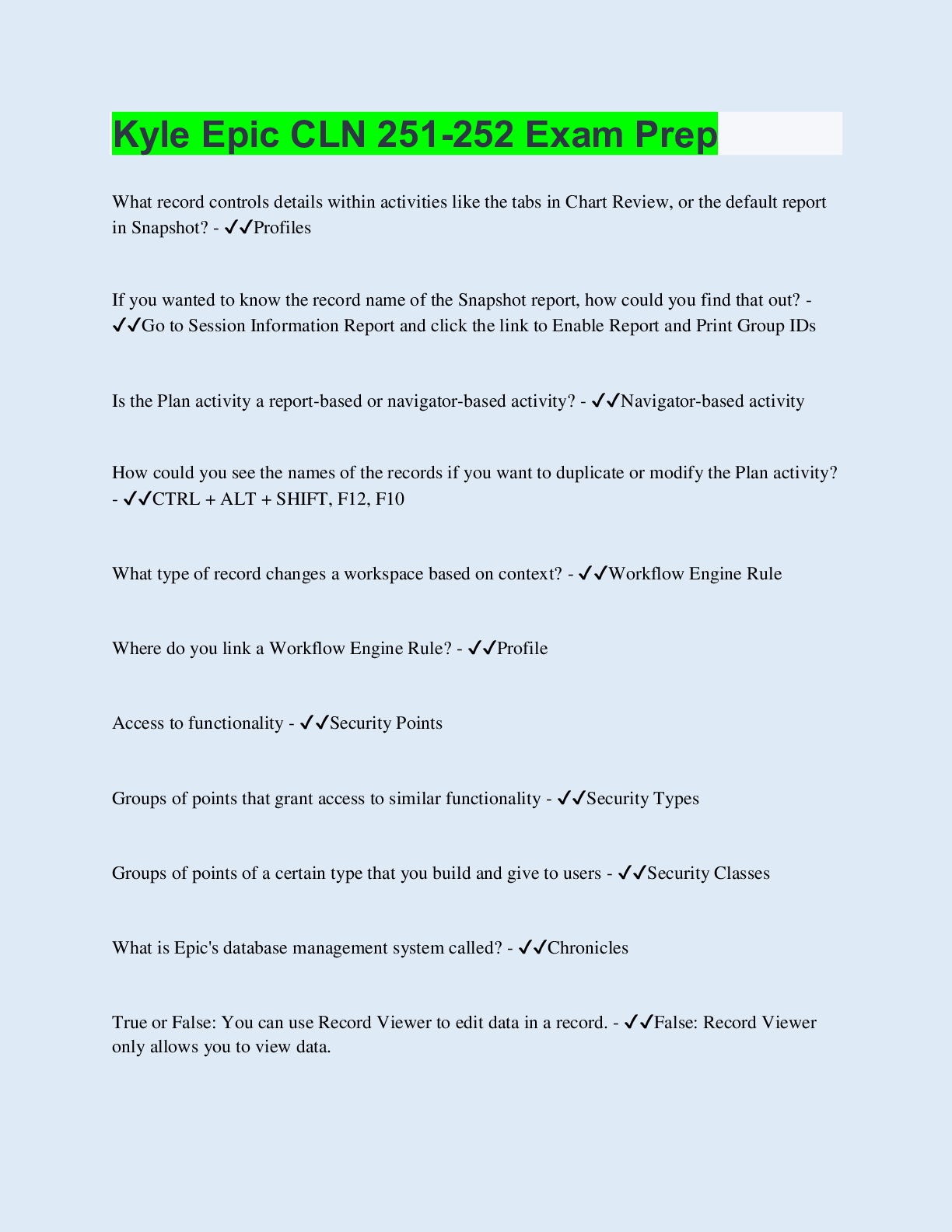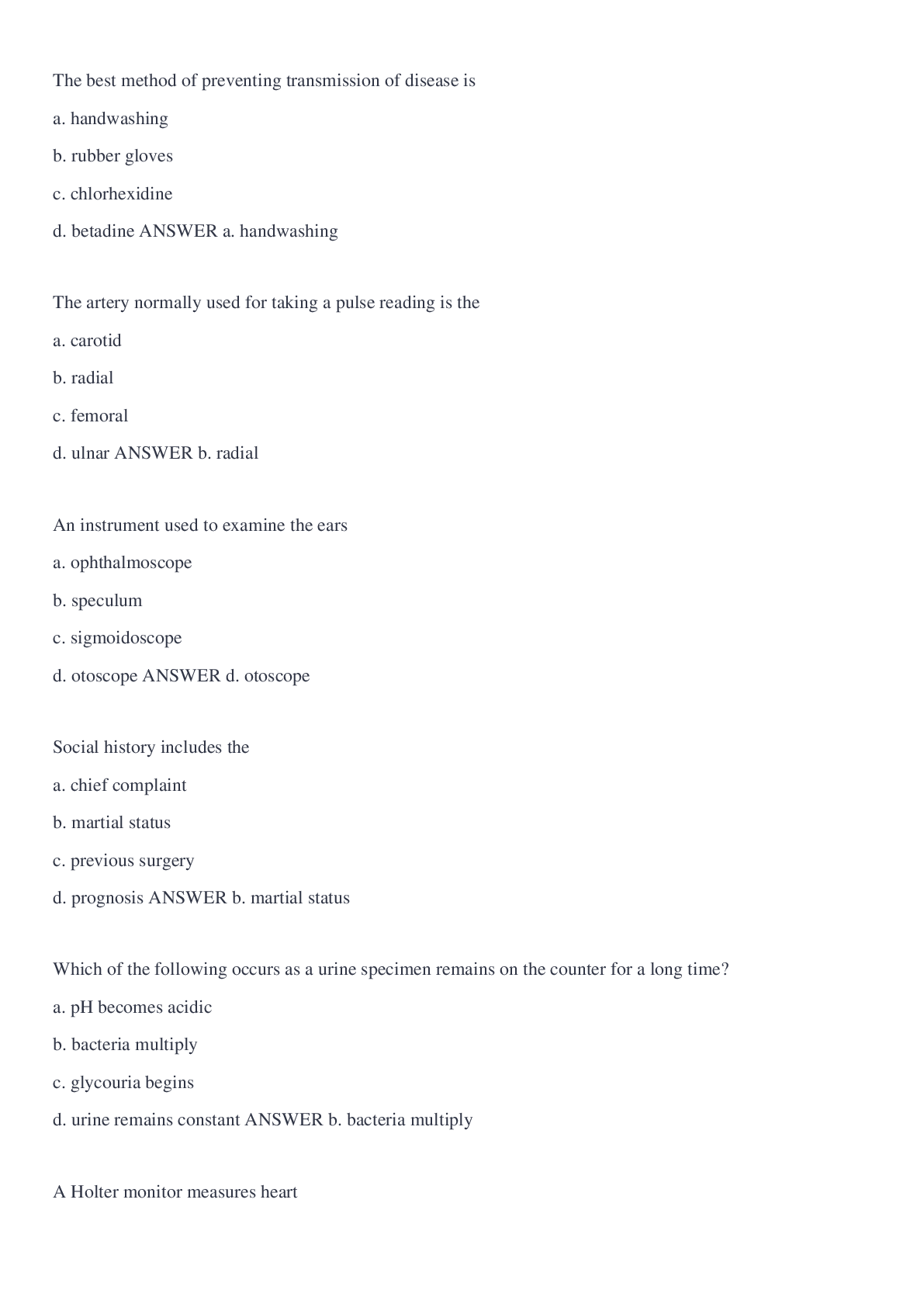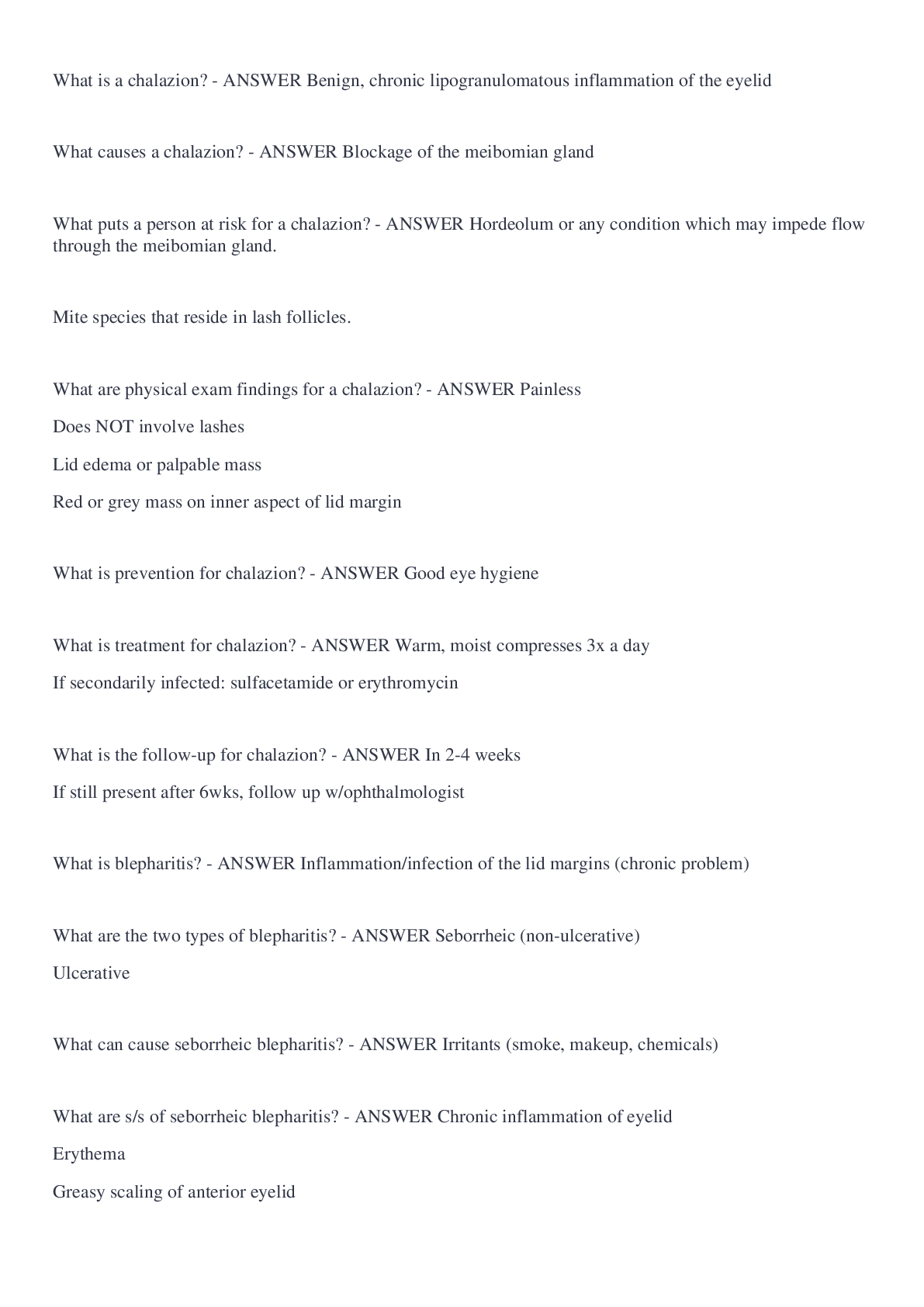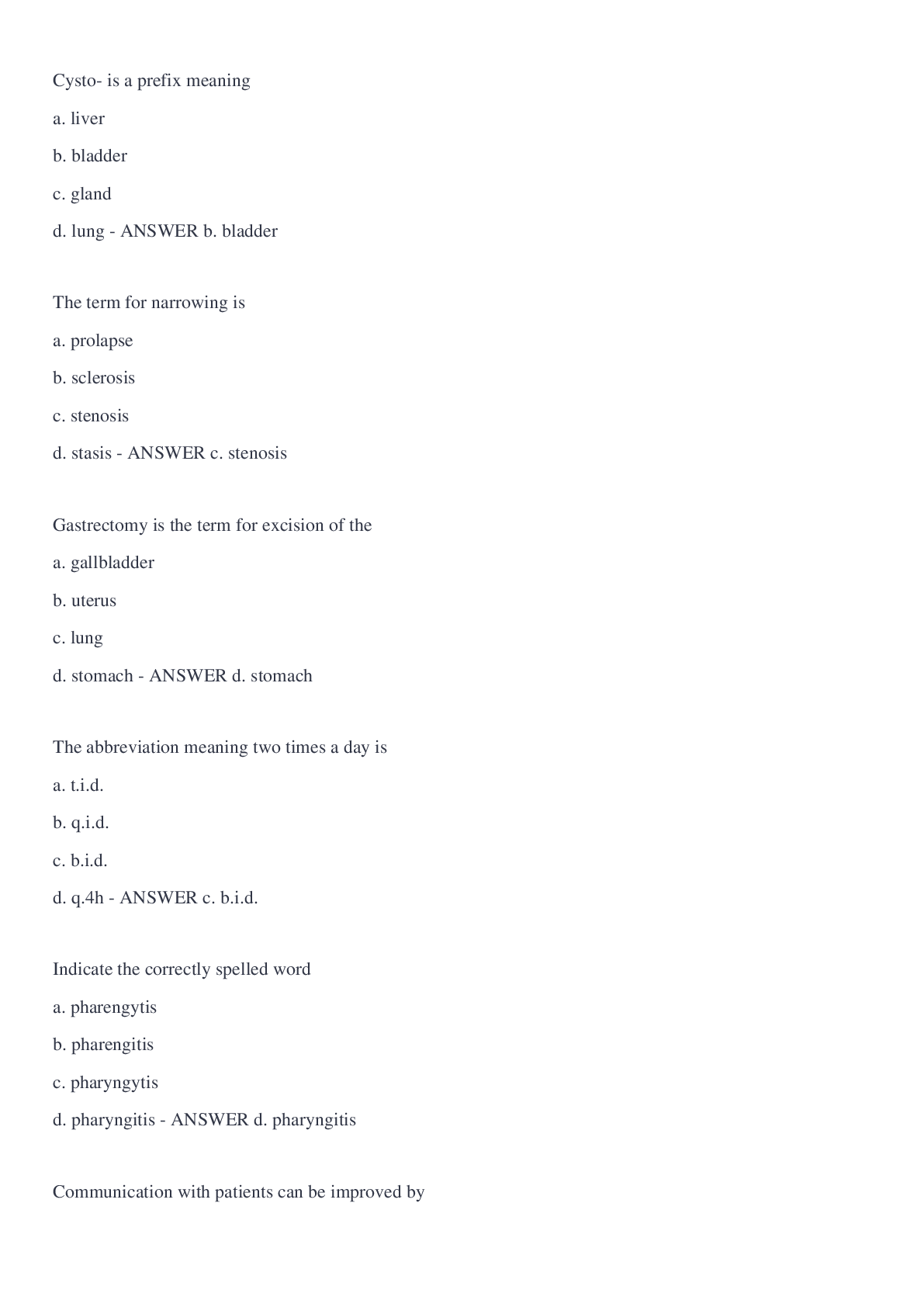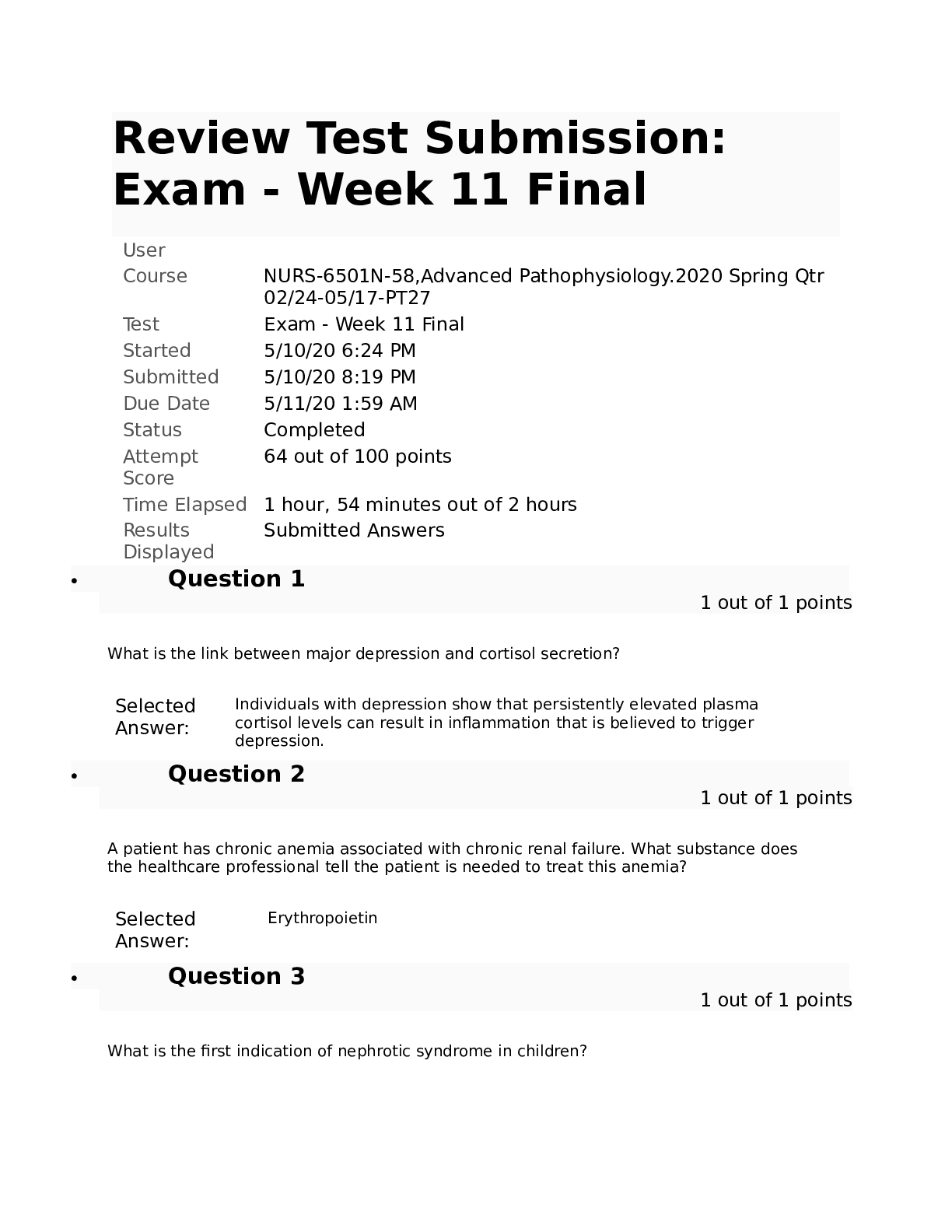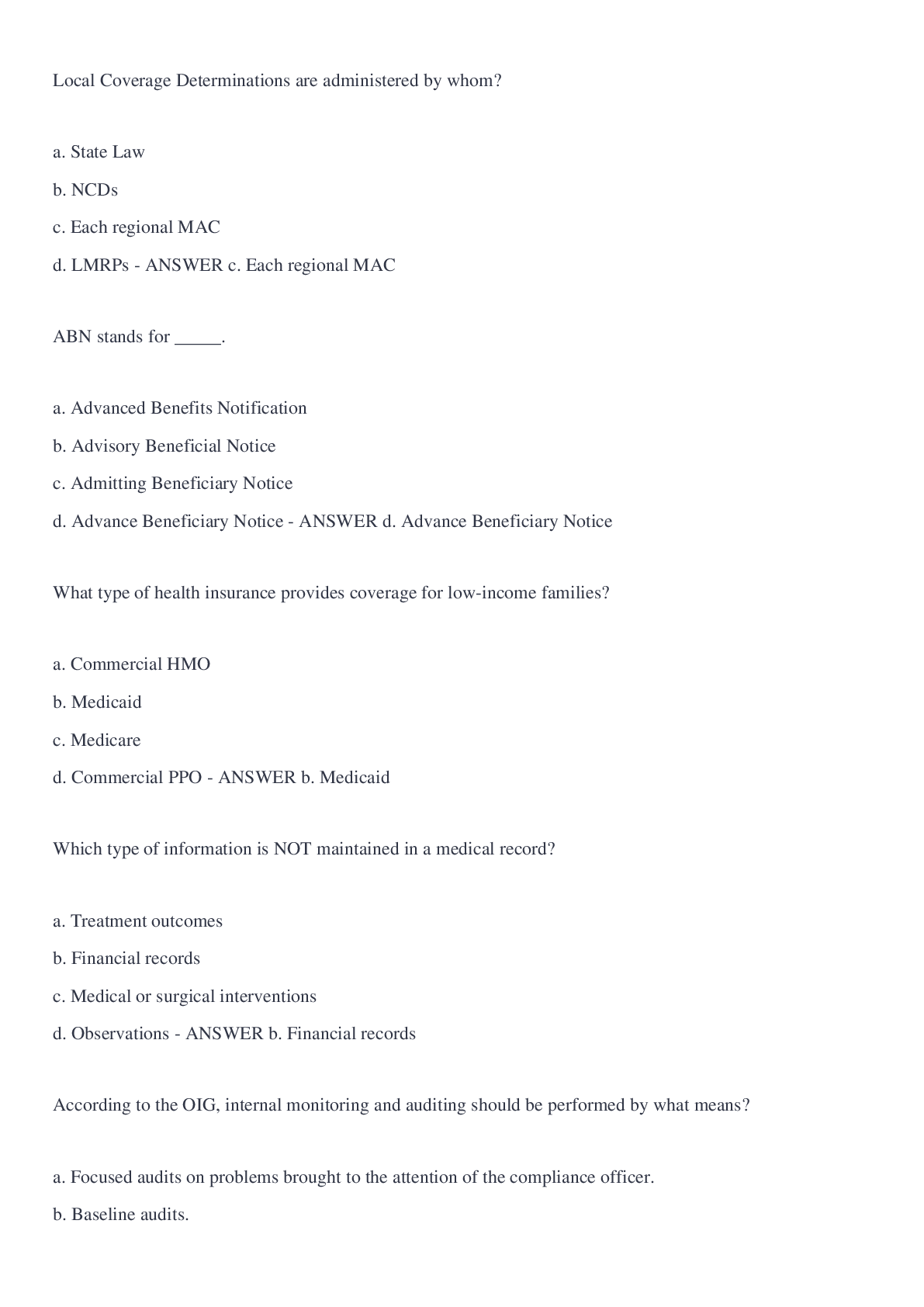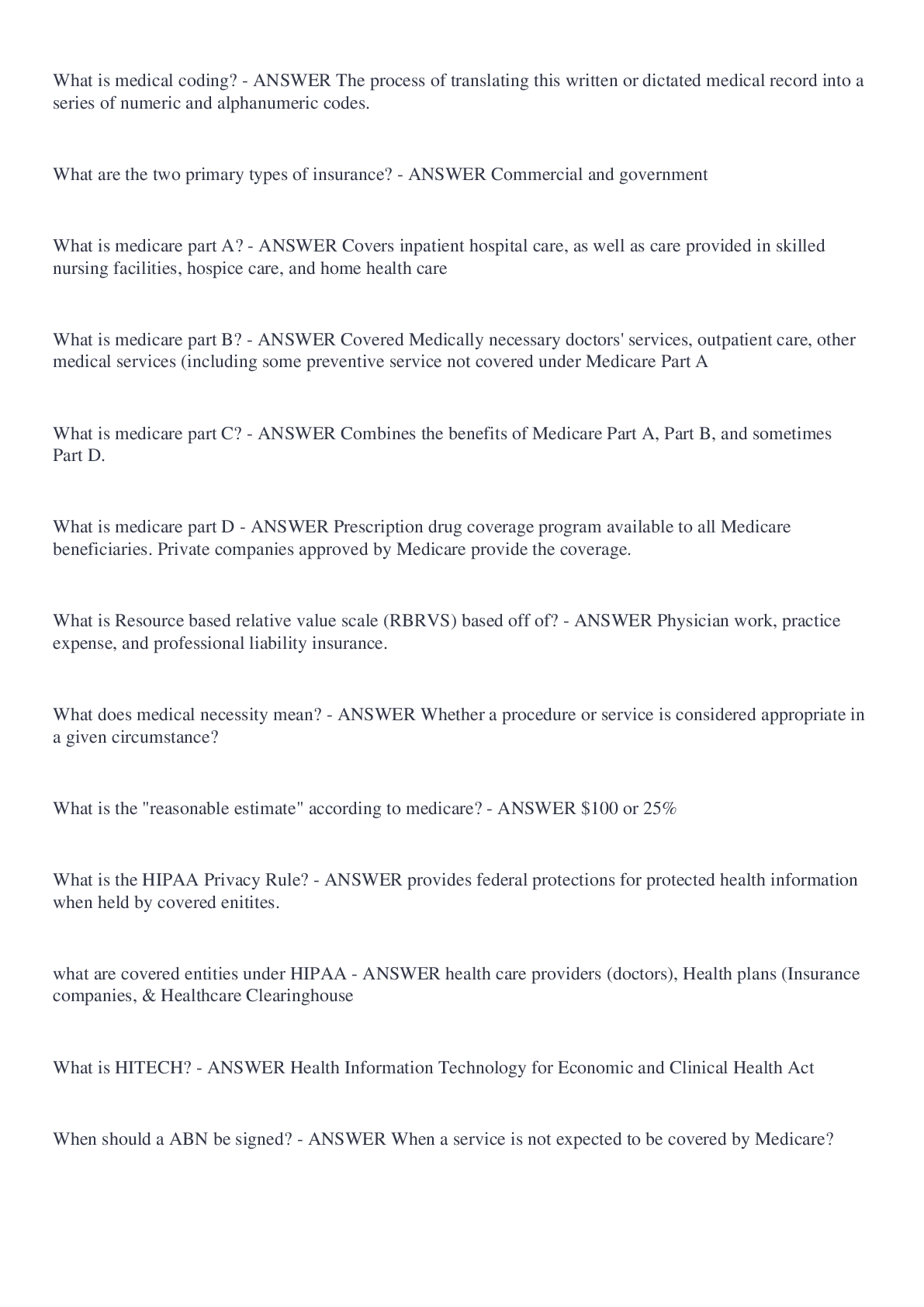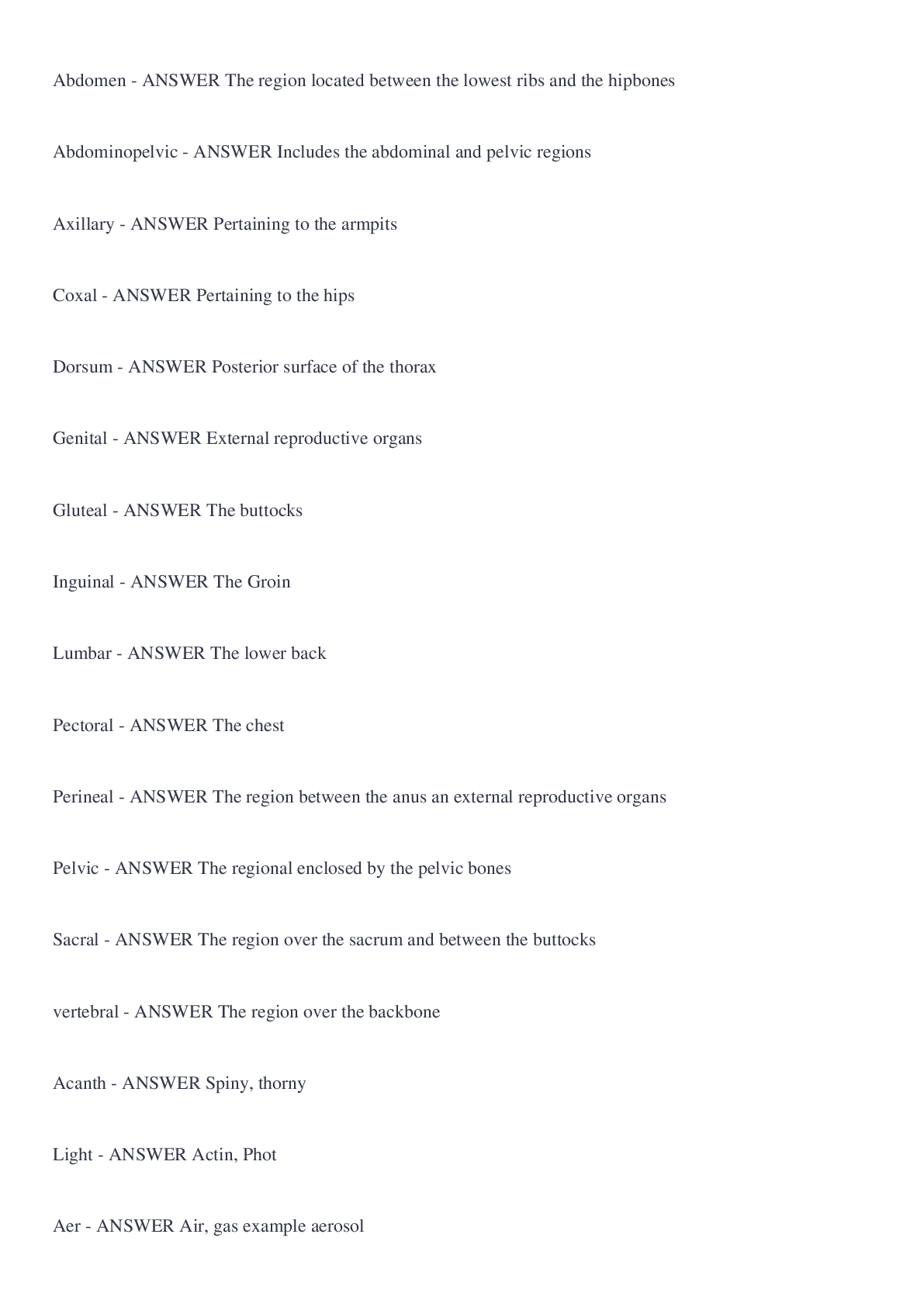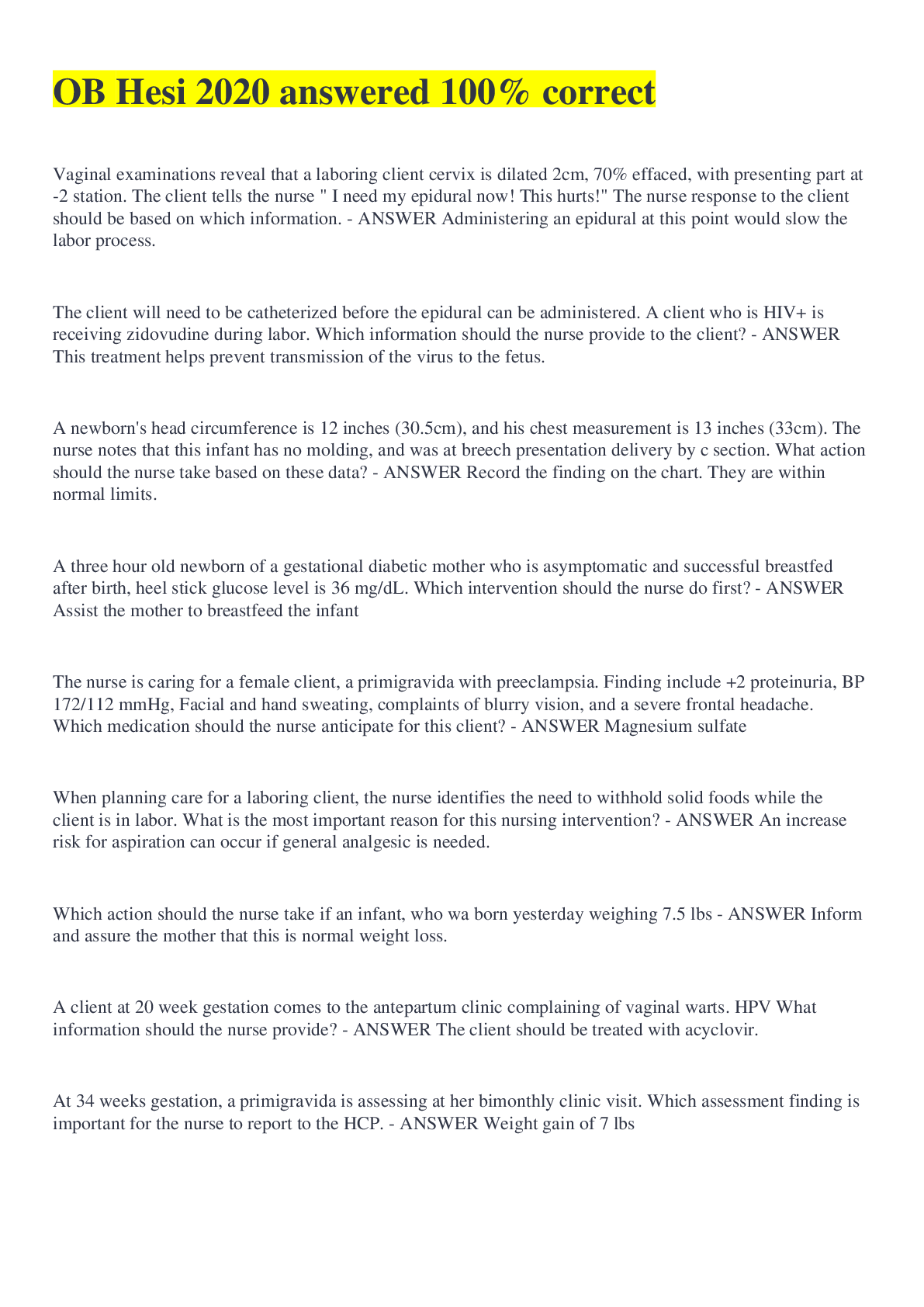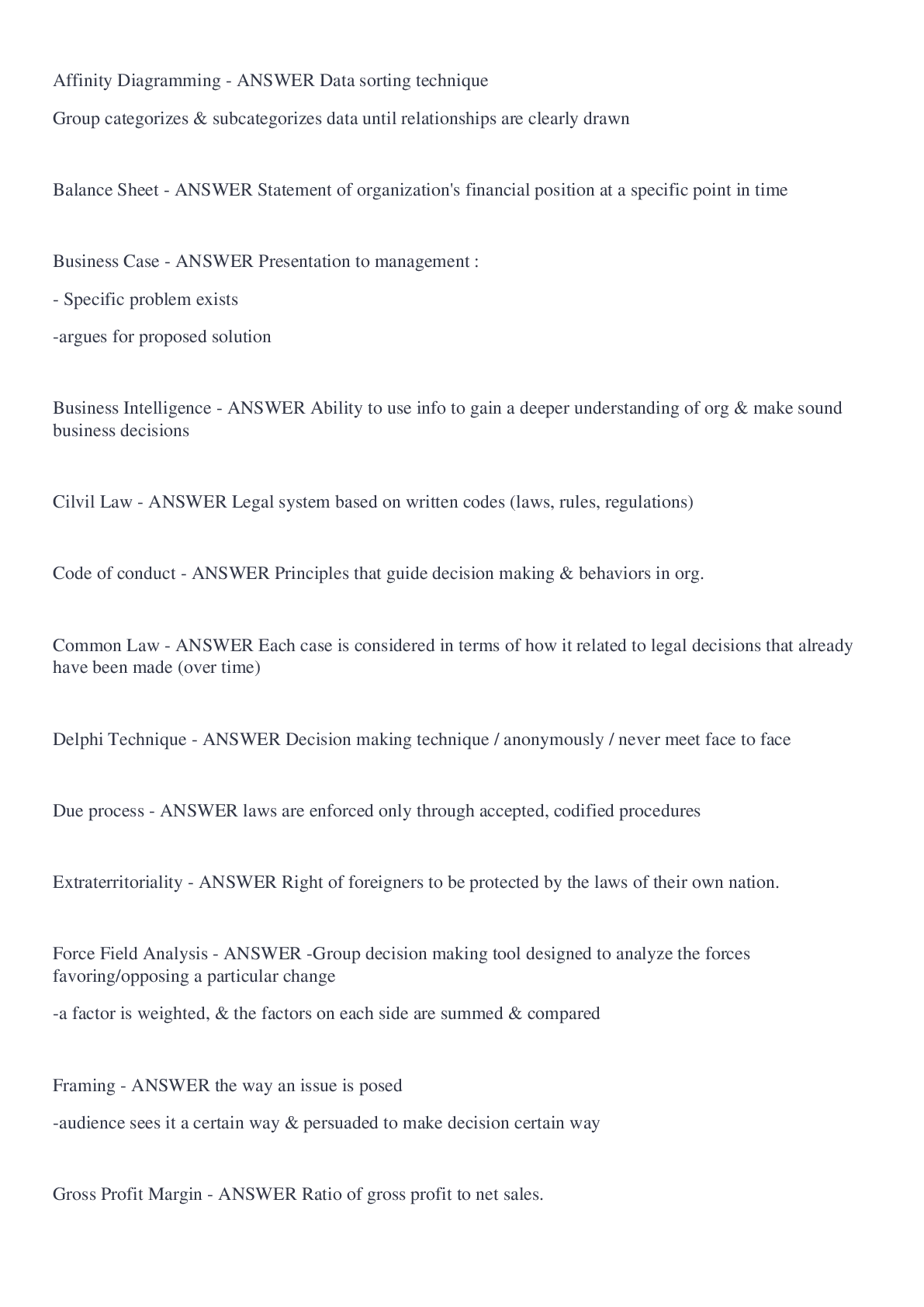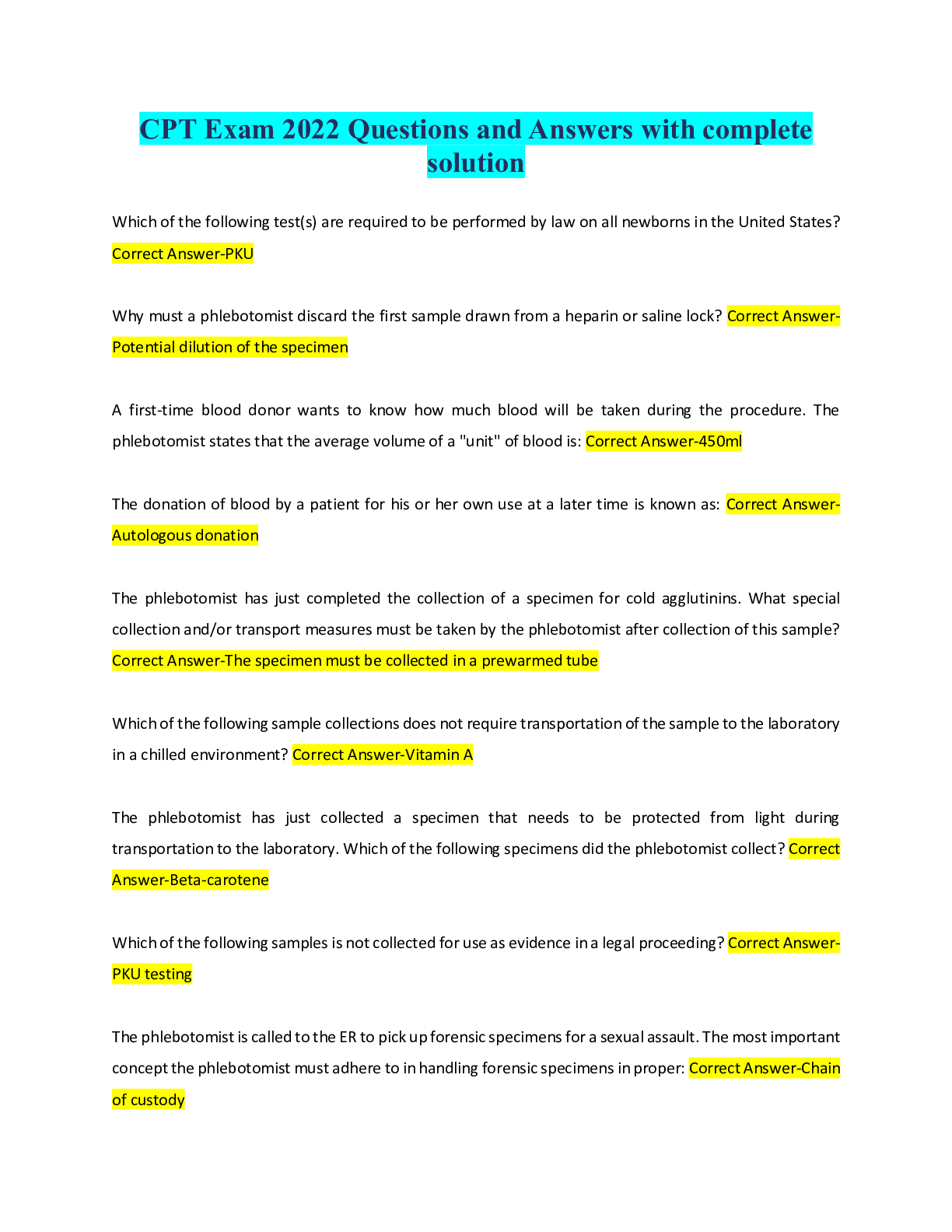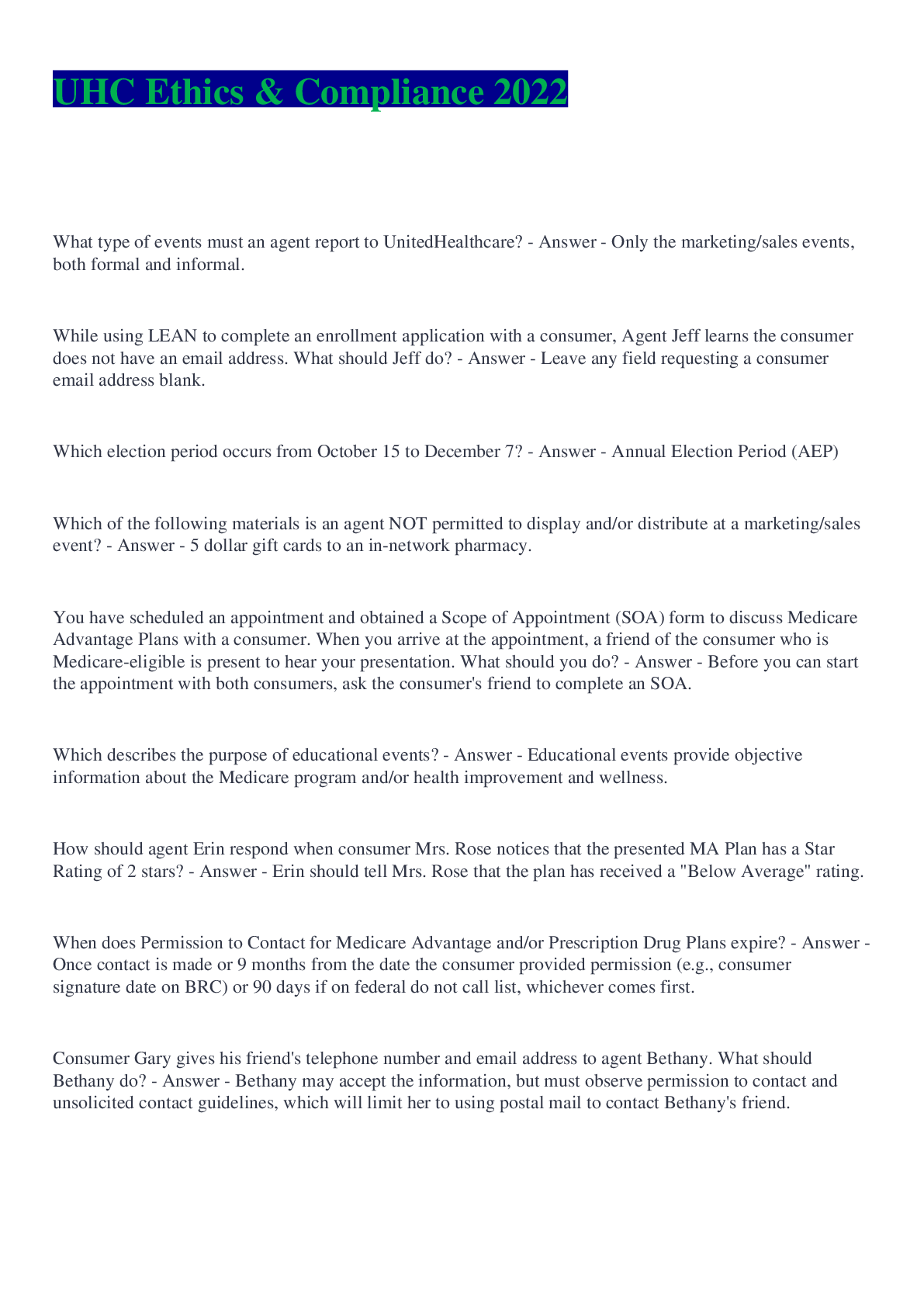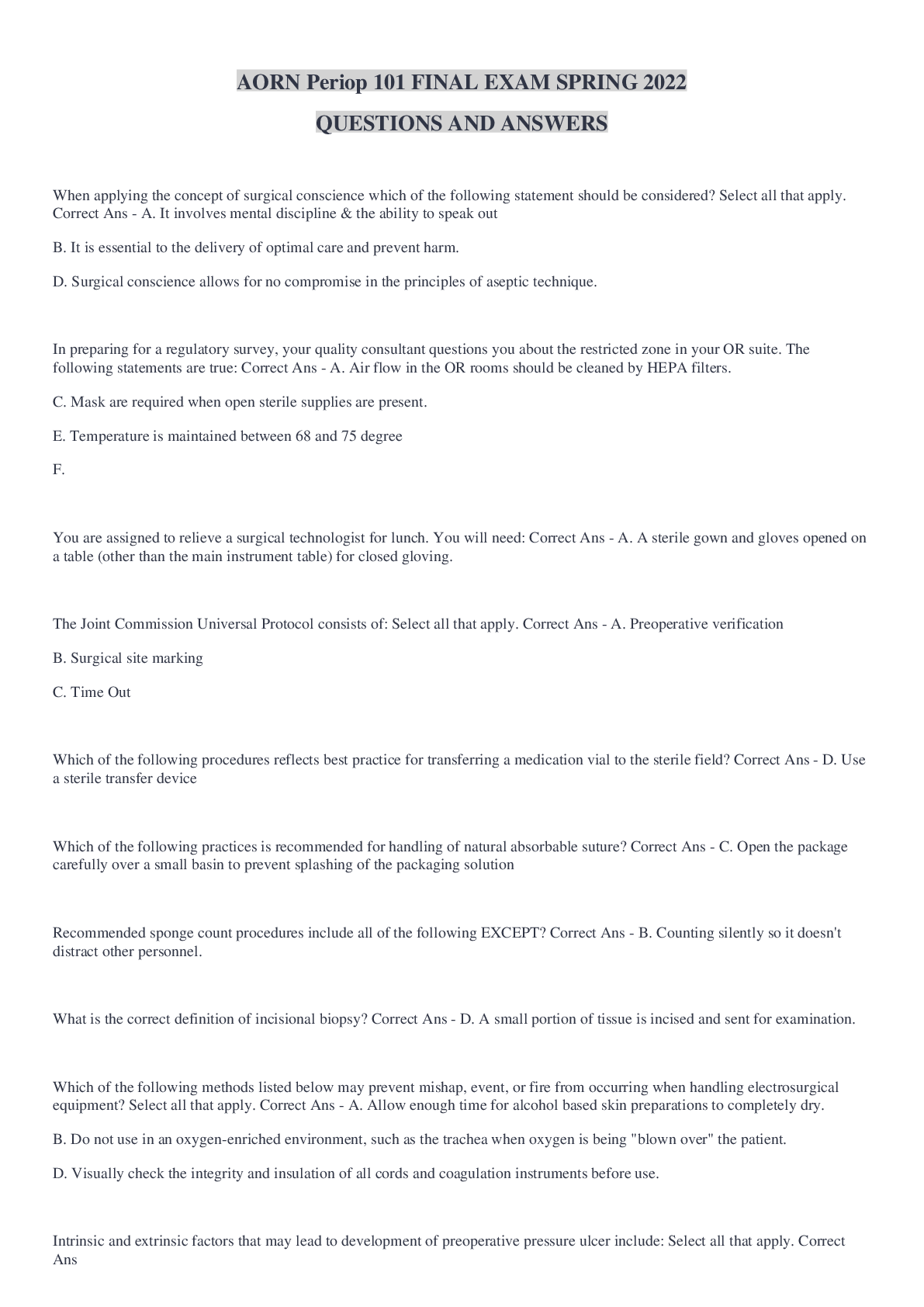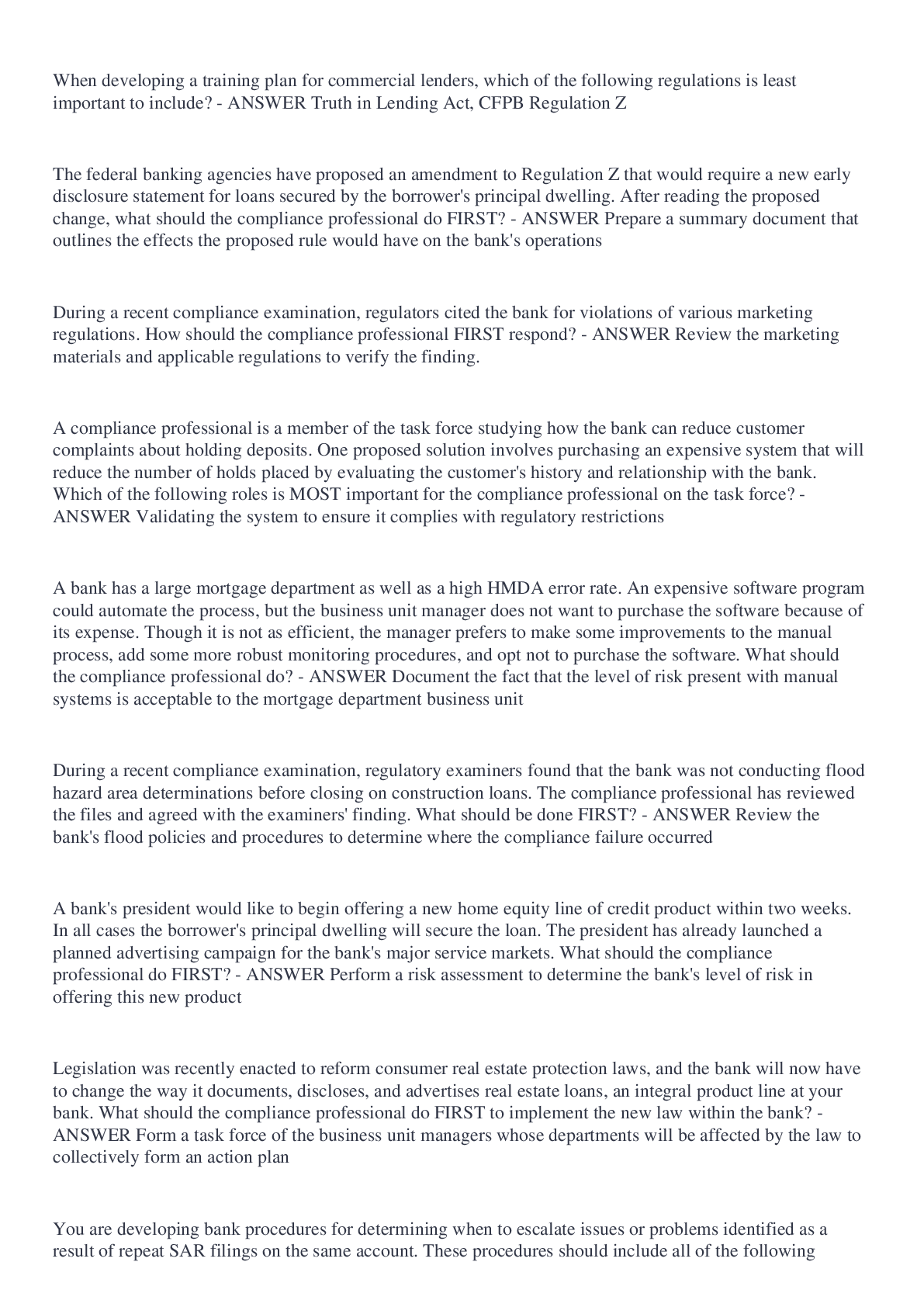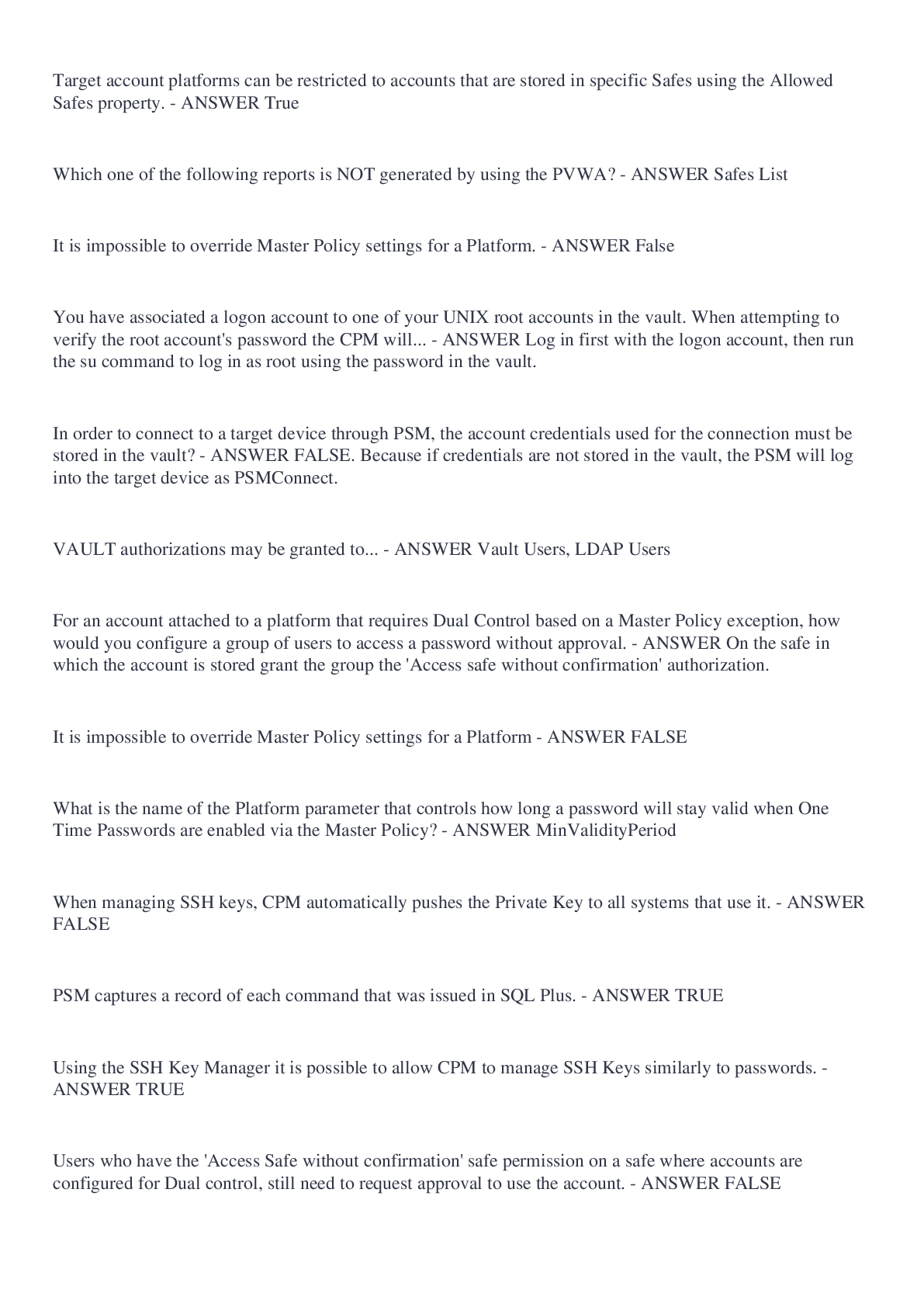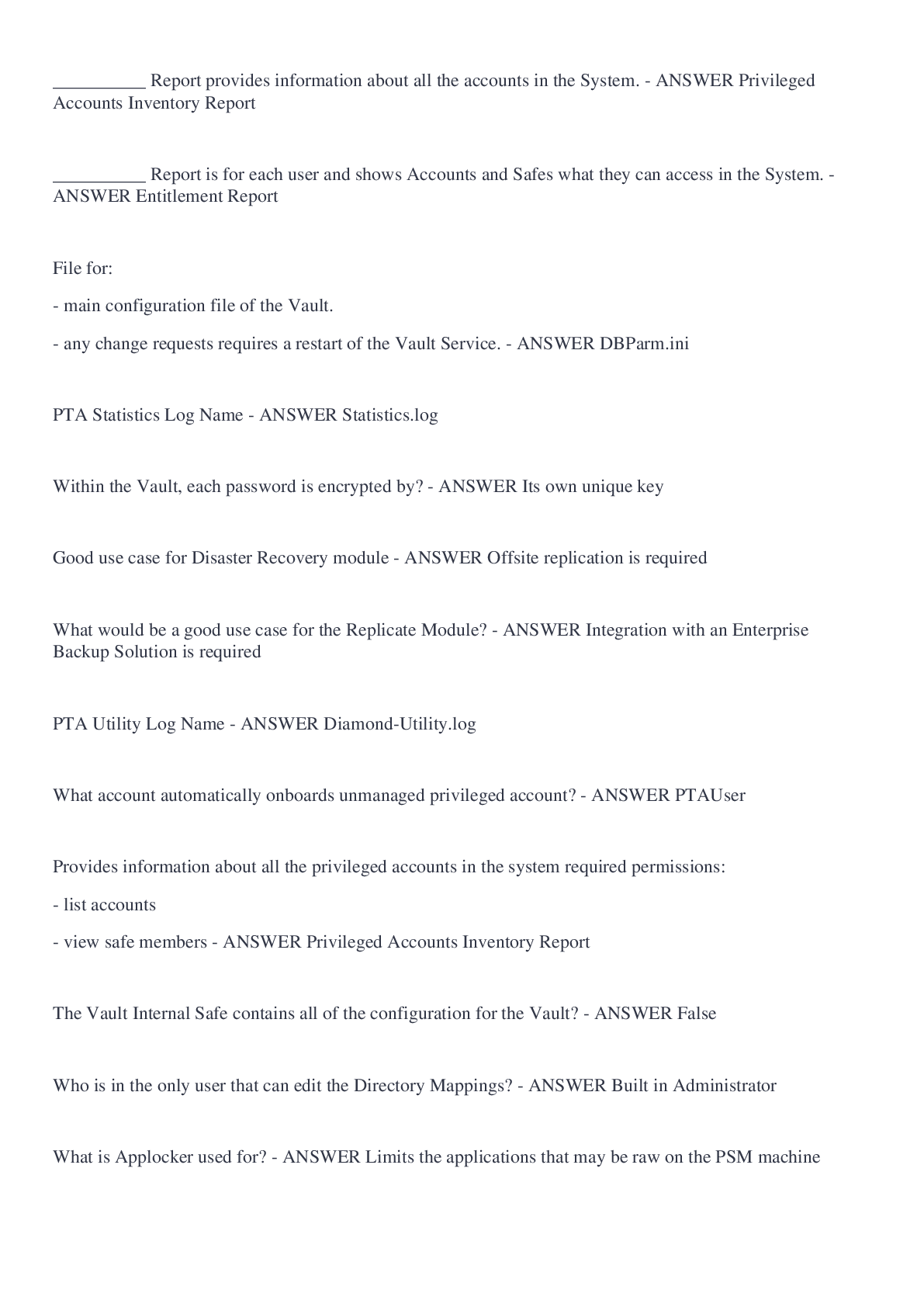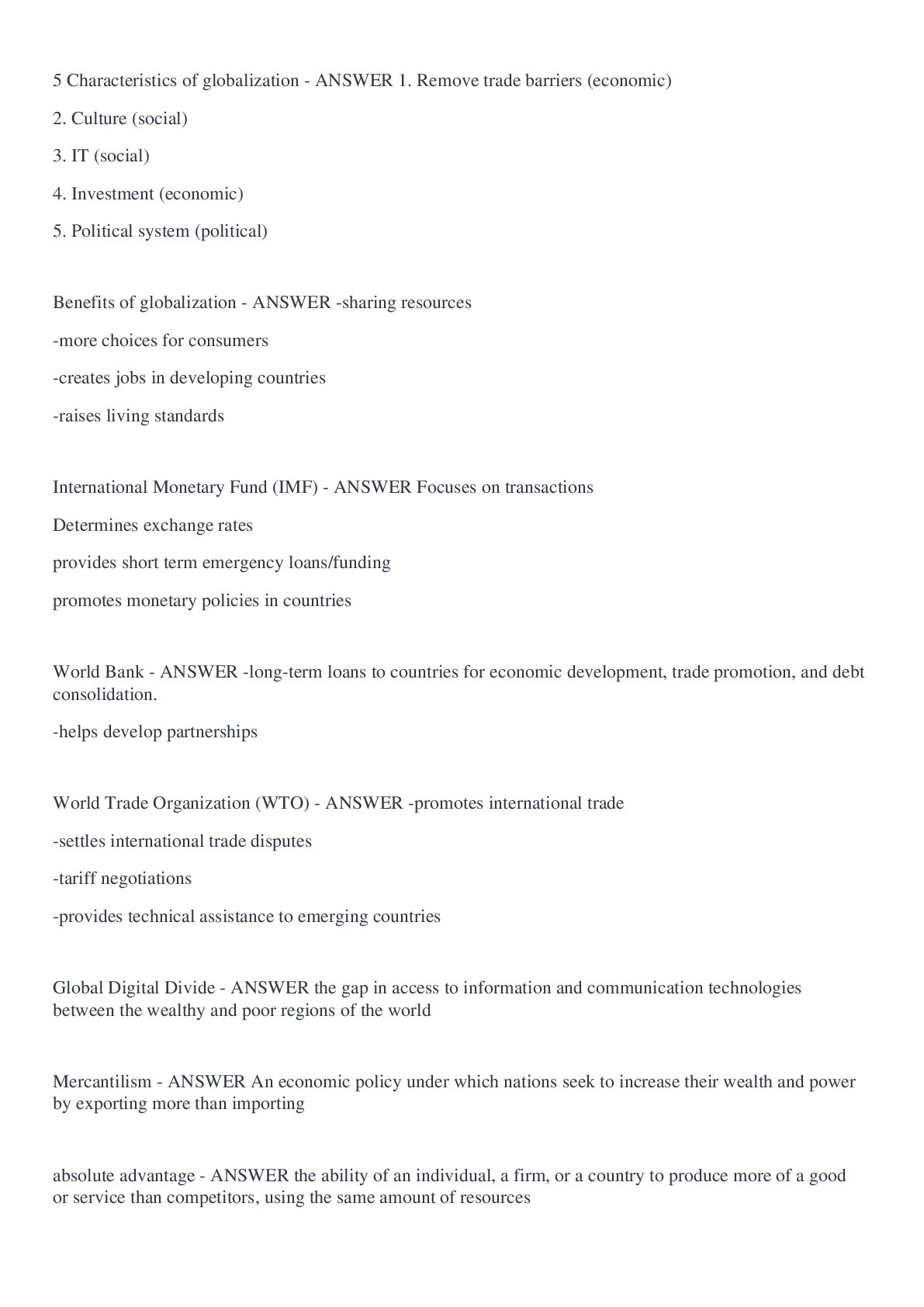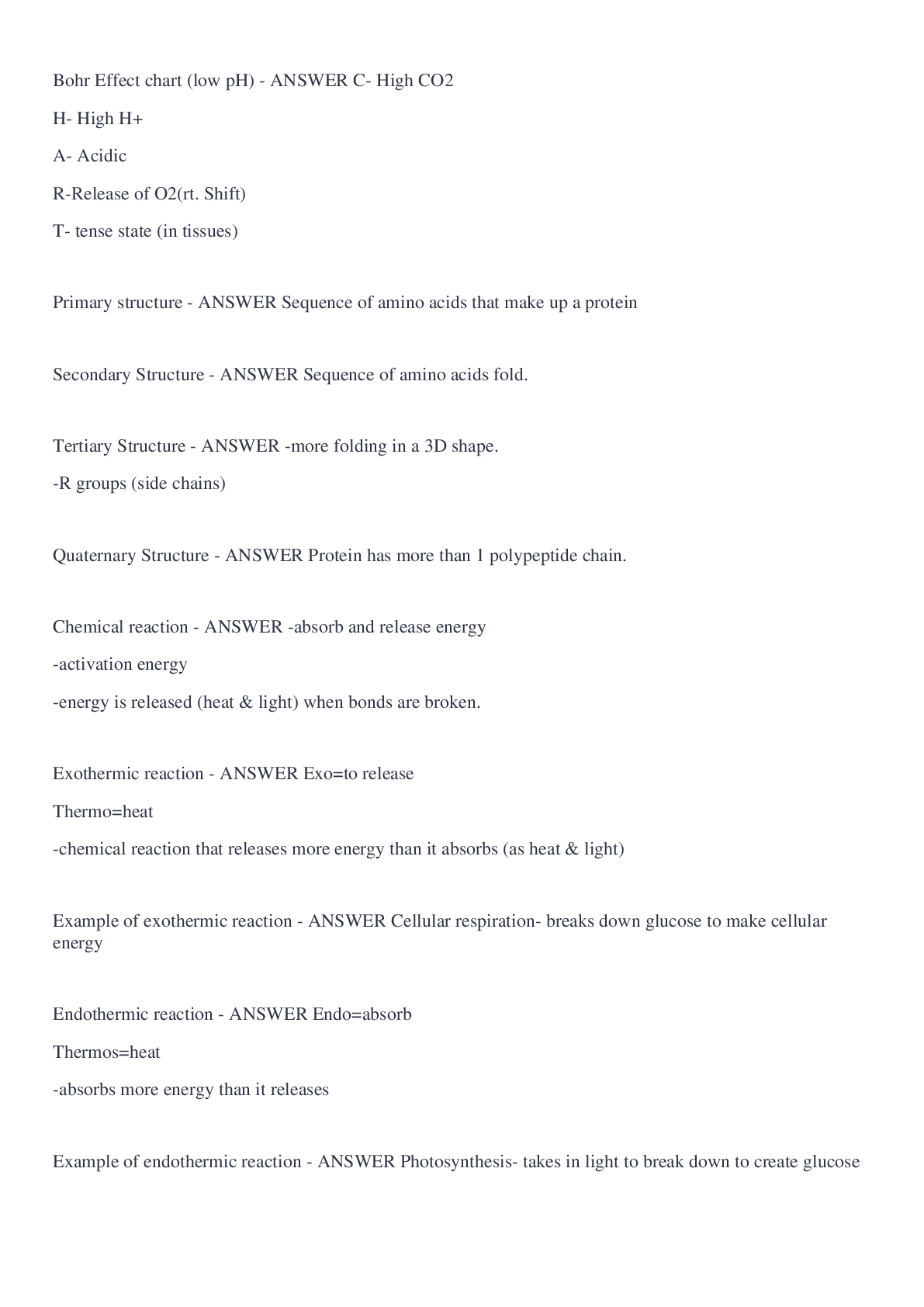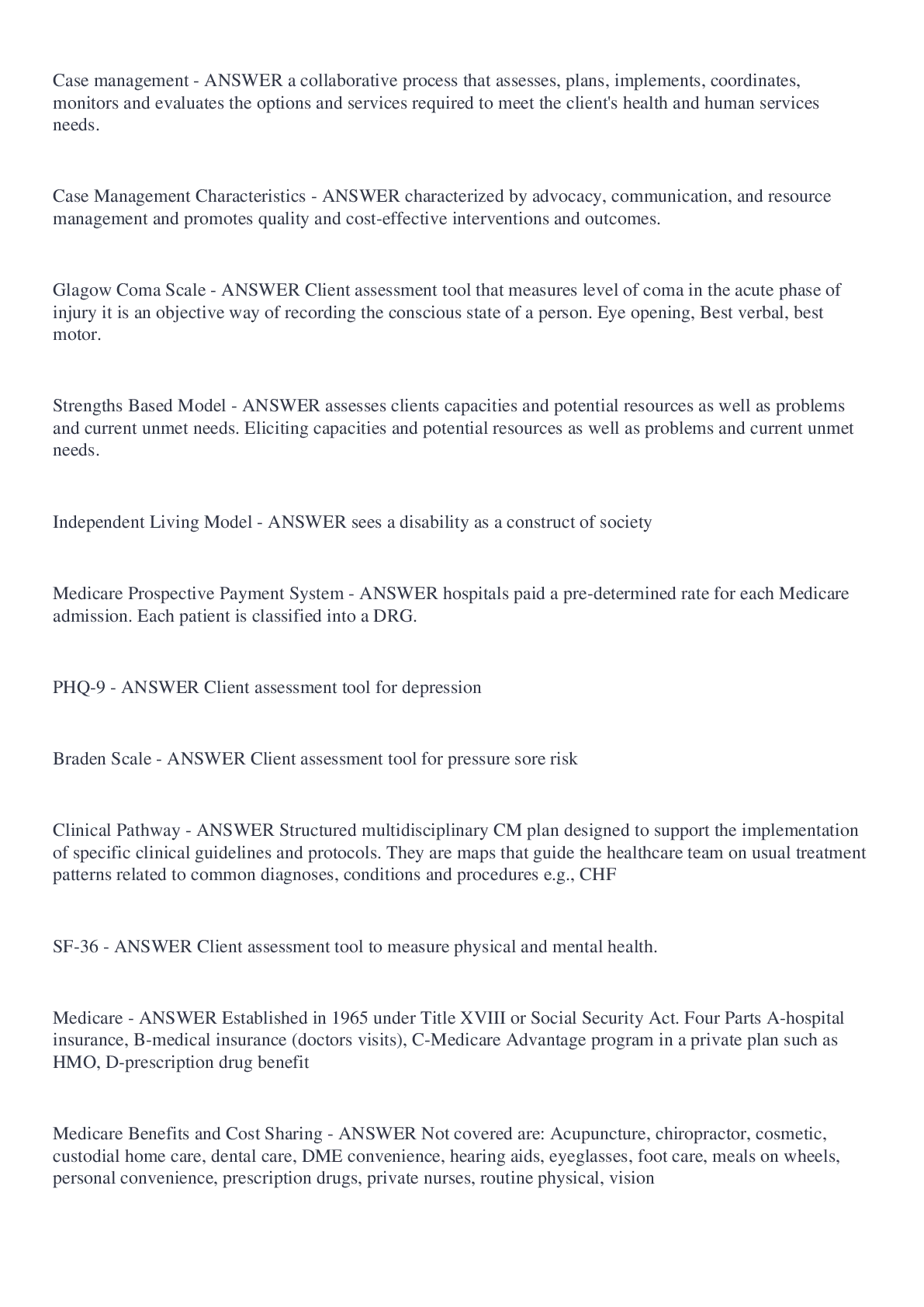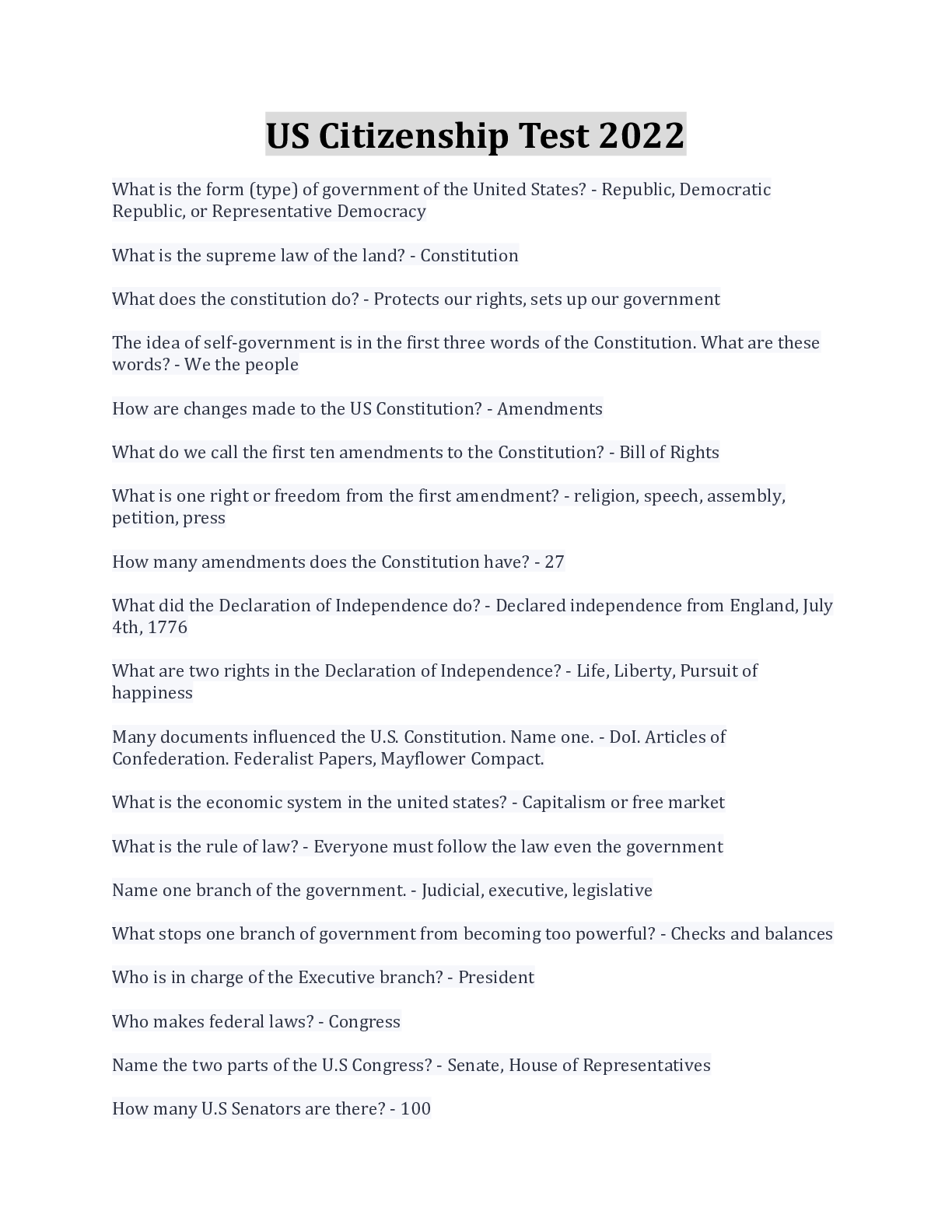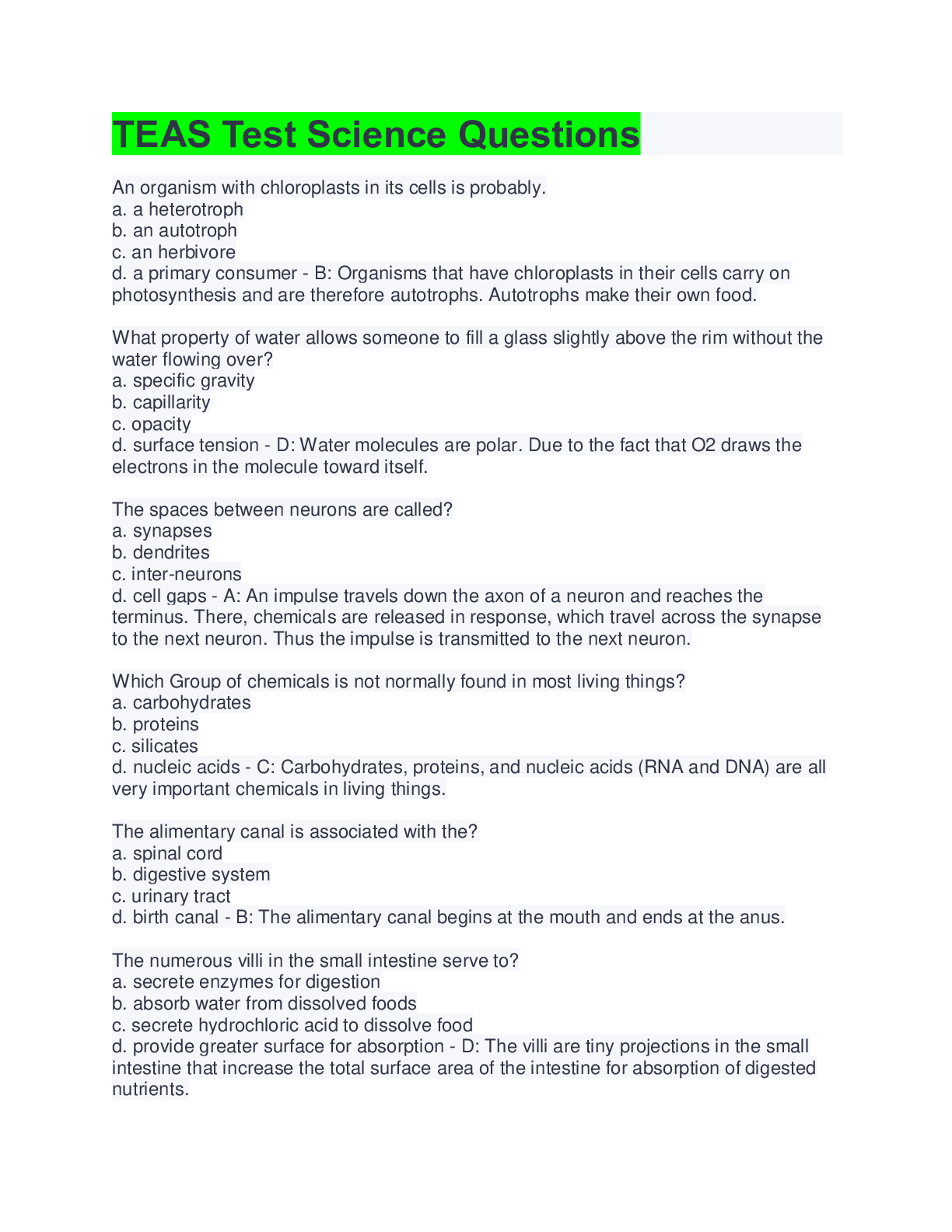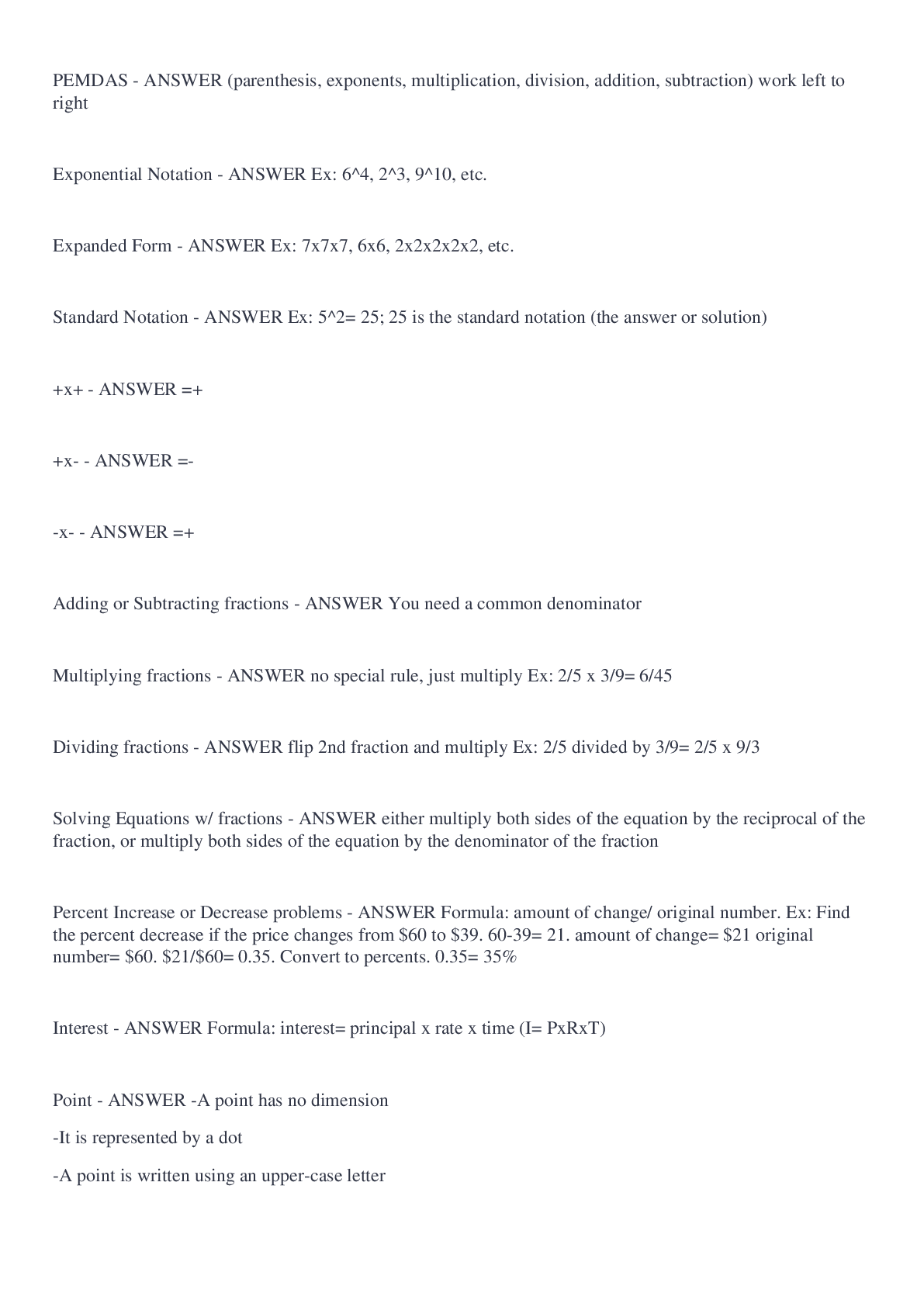Exam 1 NUR 245 (latest 2022 Questions and Answers)
Document Content and Description Below
phases of nursing - ANSWER ADPIE or ADOPIE Assessment Diagnosis planning Implementation Evaluation Nursing process A - ANSWER Assessment collect data review of clinical record health his... tory physical exam function assessment risk assessment use EBP document relevant data Nursing process D - ANSWER diagnosis- compare clinical findings with normal and abnormal variation interpret data ID clusters of cues make hypothesis test hypothesis derive dx validate dx document dx Nursing process P - ANSWER planning- establish priorities, developmental outcomes/goals (SMART goals), identify nursing interventions, document POC Nursing process I - ANSWER implementation- implement the plan in a safe and timely manner, use EBP interventions, collaborate with colleagues, coordinate care delivery, provide teaching and health promotion, document implementation and modifications Nursing process E - ANSWER Evaluate progress towards goals/outcomes, conduct systematic, ongoing, criterion based evaluation include patient and significant others use ongoing assessment to revise diagnosis, outcome, plan disseminate results to patient and family closed-ended (direct) questions - ANSWER elicit a one or two word response help you elicit specific information helpful in filling in any details originally left out highly stressed people and people with difficulty hearing will find these easier open-ended questions - ANSWER unbiased associated with non-directive interview invite clients to discover, explore, elaborate, clarify, or illustrate a thought or feeling what are the 10 traps of interviewing - ANSWER providing false assurance or reassurance giving unwanted advice using authority using avoidance language distancing using professional jargon using leading or biased questions talking too much interrupting using "why" questions when is it appropriate to use an interpreter and why are they important - ANSWER when the client has LEP, is hard of hearing, or of a different culture because LEP population are at risk for poor outcomes due to barrier that language or culture presents during health care delivery role of an interpreter - ANSWER provide verbatim translation to patient as a neutral party facilitate communication between patient and clinician what are characteristics of good interpreters - ANSWER bilingual trained interpreter familiar with medical terminology who should NOT be used as an interpreter - ANSWER family or children can result in bias sometimes will edit for the patient what are examples of objective data - ANSWER observable and measurable inspection palpation percussion auscultation think vital signs what are examples of subjective data - ANSWER what the person says about himself/herself what is EBP - ANSWER systematic approach to practice that emphasizes the use of best evidence in combination with clinician's experience, as well as patient preferences and values to make decisions about care and treatment Why is EBP important - ANSWER improves patient outcomes systematic way to review, critique, interpret, and evaluate research promotes high quality of care focus on holistic care keeps nursing care current what are some individual barriers to EBP - ANSWER nurses lack research skills in evaluating quality of research studies isolation from research knowledgeable colleagues lack of confidence to implement change what are some organizational barriers to EBP - ANSWER nurses lack time to go to libraries to research health care institutions have inadequate library research holdings lack organizational support for EBP when nurses wish to implement changes in patient care what are 5 steps to EBP - ANSWER ask clinical question acquire sources of evidence appraise and synthesize evidence apply relevant evidence in practice assess the outcomes what is acculturation - ANSWER process of adopting the culture and behavior of majority culture what is biculturalism - ANSWER reciprocal changes in both cultures and maintaining aspects of original culture in one's ethnic identity what is assimilation - ANSWER unidirectional, proceeding from unacculturated to acculturated what is acculturative stress - ANSWER the changes and losses that occur when adjusting to or integrating a new system of beliefs, routines, and social norms instrumental/environmental dimensions of acculturative stress - ANSWER language barriers finances lack of access to health care unemployment lack of education social interpersonal dimensions of acculturative stress - ANSWER loss of social networks loss of social status family conflict family separation change in gender roles intergenerational conflict societal dimensions of acculturative stress - ANSWER legal status level of acculturation stigmas discrimination poltical/historical factors spirituality - ANSWER broader term focusing on the connection to something larger than oneself and a belief in transcendence culture - ANSWER complex phenomenon including attitudes, beliefs, self-definitions, norms, roles, and values 4 characteristics of culture - ANSWER learned from birth through the process of language acquisition and socialization shared by all members of the same cultural group adapted to specific conditions related to environmental and technical factors and availability to natural resources dynamic cultural competence - ANSWER Attitudes, knowledge, and skills necessary for providing quality care to diverse populations interact effectively with people of different cultures cultural humility - ANSWER showing you want to learn, being open, being humble in your approach to others essential components of critical thinking - ANSWER Use ADPIE Identify abnormal data cluster data draw inferences purpose nursing diagnosis check for presence of defining characteristics confirm or rule out nursing diagnosis document conclusions disadvantages on note takin during interview - ANSWER breaks eye contact too often shifts attention away from person changes natural mode of expression of person impedes your observation of nonverbal communication threatening to client during sensitive discussion advantages of note taking - ANSWER increased accuracy considerations for interviewing older adults - ANSWER address by last name use proper titles unless otherwise informed avoid "elder speak" allow enough time for them to receive, interpret and process info interview takes longer may need to break up into multiple parts or take breaks consider physical limitations touch is important (other senses may be diminished) process of terminating an interview - ANSWER ask if there is anything else they would like to mention or if they have any questions make closing statement give summary of interview say thank you principles of setting immediate priorities - ANSWER complete health history- allergies medications current medical problems reason for visit determine relationship between problems (ex rib pain causing SOB is higher priority than rapid pulse) steps to assigning immediate priorities - ANSWER first level= ABCs second level= mental status change, acute pain, infection risk, abnormal labs, elimination problems third level= lack of knowledge, mobility problems, family coping therapeutic communication - ANSWER a form of communication that puts focus on the mental, emotional, and physical well being of the patient while always maintaining professionalism key components of therapeutic communication - ANSWER empathy respect genuineness concreteness confrontation steps to becoming culturally competent - ANSWER understand one's own culture (heritage, beliefs, attitudes, practices) ID the meaning of health to the patient understand how health care systems work acquire knowledge about social background of patients become familiar with languages, interpretive services, and community resources available to nurses and patients empathy - ANSWER viewing the world from another person's inner frame of reference while remaining you why is empathy important in nursing assessment - ANSWER builds trust with patient patient feels accepted and that they can deal with problem openly nursing considerations for allergies - ANSWER note allergen and reaction do not list unpleasant side effects components of the complete health history - ANSWER biographic data source of history - reliability? chief complaint HPI past health history-including allergies, current meds family history ROS functional assessment-including social history perception of health characteristics of a conducive interview environment - ANSWER comfortable temp privacy quiet sufficient lighting no distractions physical distance (4-5ft) equal status seating face to face 9 types of verbal communication - ANSWER facilitation silence reflection empathy clarification confrontation interpretation explanation summary non verbal communication interviewer can make - ANSWER physical appearance posture gestures facial expressions eye contact voice touch (only if given permission) patients with high fall risk - ANSWER older adults with multiple contributing factors such as: gait and balance problems poor vision syncope diabetic neuropathy home hazards (uneven steps, throw rugs) dementia when do you perform a full mental assessment - ANSWER screening suggests depression, anxiety, or other psychiatric mental illness family members are concerned about abnormal behavior brain lesions aphasia (loss of ability to understand or express speech, caused by brain damage) symptoms of psychiatric mental illness what does verbal communication tell us - ANSWER assist in the narrative part of interview open and closed ended questions what does nonverbal communication tell us - ANSWER establishes rapprt conveys info can tell us if verbal message is not true provide cues to understand feelings can give cues on how they are feeling (ex anxious or uneasy) household items that could potentially cause safety issues - ANSWER loose throw rugs inadequate lighting obstructed hallway curled carpet edges cords in walkways lack of grab bars low/loose toilet seats uneven or tall steps components of functional assessment for an elderly patient - ANSWER self care (ADLs) self maintenance (IADLs) physical mobility (must be asked and observed) what are ADLs - ANSWER Acts of Daily Living (self care tasks) eating/feeding bathing grooming dressing toileting walking using stairs transferring what are IADLs - ANSWER Instrumental Activities of Daily Living- functional abilities necessary for independent living shopping meal prep housekeeping laundry managing finances taking medications using transportation how is therapeutic communication maintained in uncomfortable situations - ANSWER use empathy ID and cope with your own feelings first so you can do what is best for client how is therapeutic communication maintained with clients with sexual abuse and what sort of interview skills should be used - ANSWER privacy safety empathy how is pain addressed in nursing assessment (2 pneumonics) - ANSWER OPQRST OLDCARTS O-onset P-provocation/ quantity Q- quality/quantity R-region/ radiation S severity scale T-timing O- onset L-location D-duration C-characteristics A-alleviating/ aggravating R- relieving factors/radiation T-timing S-severity acute pain - ANSWER signals/warns of tissue damage short term (<6months) self limiting chronic pain - ANSWER greater than or equal to 6 months no known cause or treatment somatic pain - ANSWER originates from musculoskeletal system, bones/joints "sharp, burning"= cutaneous (relating to or affecting the skin) visceral pain - ANSWER abdominal organs dull "crampy, gnawing" two types or processes of pain - ANSWER nociceptive neuropathic what are nociceptors - ANSWER specialized nerve endings designed to detect painful sensations from periphery and transmit to CNS body parts with nociceptors - ANSWER skin joints connective tissue muscle thoracic, abdominal and pelvic viscera two primary afferent (sensory) pathways that carry nociceptive signals - ANSWER free nerve ending of alpha and C fibers alpha fibers - ANSWER myelinated larger diameter carry pain rapidly to CNS localized, short term sharp pain C fibers - ANSWER unmyelinated smaller diameter slow conducting diffuse, aching sensatins that last longer after initial injury what is the afferent pathway - ANSWER sensory carries pain stimuli from PNS to CNS what is the efferent pathway - ANSWER motor pathway, muscle carries nerve impulses from CNS to PNS phases of nociception - ANSWER transduction transmission perception modulation what happens during transduction - ANSWER pain felt to due to messages from nerve endings releases: histamine, substance P, serotonin, bradykinin, prostaglandins--> sensitizes nerve endings sending pain message from injury to dorsal horn spinal cord (AFFERENT PATHWAY) what happens during transmission - ANSWER pain impulse move from dorsal horn of spinal cord to brain what happens during perception - ANSWER conscious awareness of painful sensation limbic system-emotional response somatosensory areas- characterize sensation what happens during modulation - ANSWER neurons from brainstem release NTs that block pain impluses release NTs that produce analgesic effect (serotonin, norepi, neurotension, GABA, beta endorphind, enkephalins, dynorphins) what is neuropathic pain - ANSWER pain caused by lesion or disease in somatosensory nervous system what are some examples of conditions that can cause neuropathic pain - ANSWER diabetes shingles HIV/AIDS sciatica trigeminal neuralgia phantom limb pain chemotherpay stroke MS tumor what is neuronal "wind-up" - ANSWER central neuron hyper-excitability which leads to maintenance to neuropathic pain minor stimuli cause significant pain considerations to pain assess for elderly client - ANSWER remember pain is NOT a normal process of aging despite being common experience to those >65 years of age mental status doesn't impact ability to experience pain (dementia) evaluate body language instead of verbal communication DO NOT perceive pain to lesser degree nor diminished sensitivity behavioral cues for pain asses in elderly clients - ANSWER changes in functional status changes in dressing, walking, toileting, involvement in activities (ADLs and IADLs) slowness, rigidity fatigue sudden onset of acute confusion components of mental status exam - ANSWER A-appearance B-behavior C-cognition T-thought processes What health history factors affect mental status examination - ANSWER known illnesses/health problems (eg-alcohol abuse, chronic disease) current meds with side effects that may cause depression/confusion unusual educational and behavioral level responses to personal history questions (stress, social interaction patterns, sleep habits, drug/alcohol use) mental status examination examples - ANSWER mini-cog timed up and go (TUG) MMSE MoCA Mini-Cog - ANSWER reliable, quick (3-5 min) , easily available screening for cognitive impairment in otherwise healthy older adults3-item recall test, clock drawing test tests executive function, includingability to planmanage timeorganize activitiesmanage working memory can be used w/ varied culture groups + literacy levels NOT influenced by education/health literacy Score 0-5; <3 is suggests dementia but some cognitive impairment can not be ruled out with scores of 3, 4, or 5 (TUG) Timed up and go - ANSWER quantify functional ability rise from chair, walk 10 feet, turn, walk back to chair, sit down factors to notesitting balancetransferring (sitting--> standing)gait pace and stabilityability to turn without staggeringsitting back down in chair >12 seconds = high fall risk, ?further eval MMSE - ANSWER Mini mental state exam Tests cognitive function through orientation, registration, attention and calculation, recall language score up to 30, =, < 23 = cognitive impairment can help diagnose dementia considerations about MMSE - ANSWER Use with caution in low educated patients or with learning disabilities Not sensitive for mild cognitive impairment MoCA - ANSWER Montreal cognitive assessment examines more domains than MMSE more sensitive to MILD COGNITIVE IMPAIRMENT <10 mins to administer total score = 30, >26 normal what does MoCA measure - ANSWER visuo-constructive ability language function memory auditory attention conceptual thinking working memory and calculations speech/language inspection - ANSWER Concentrated watching palpation - ANSWER applies your sense of touch to assess the body, especially while perceiving/diagnosing a disease or illness percussion - ANSWER tapping on the person's skin with shirt, sharp, strokes to assess underlying structures auscultation - ANSWER listenin [Show More]
Last updated: 1 year ago
Preview 1 out of 16 pages
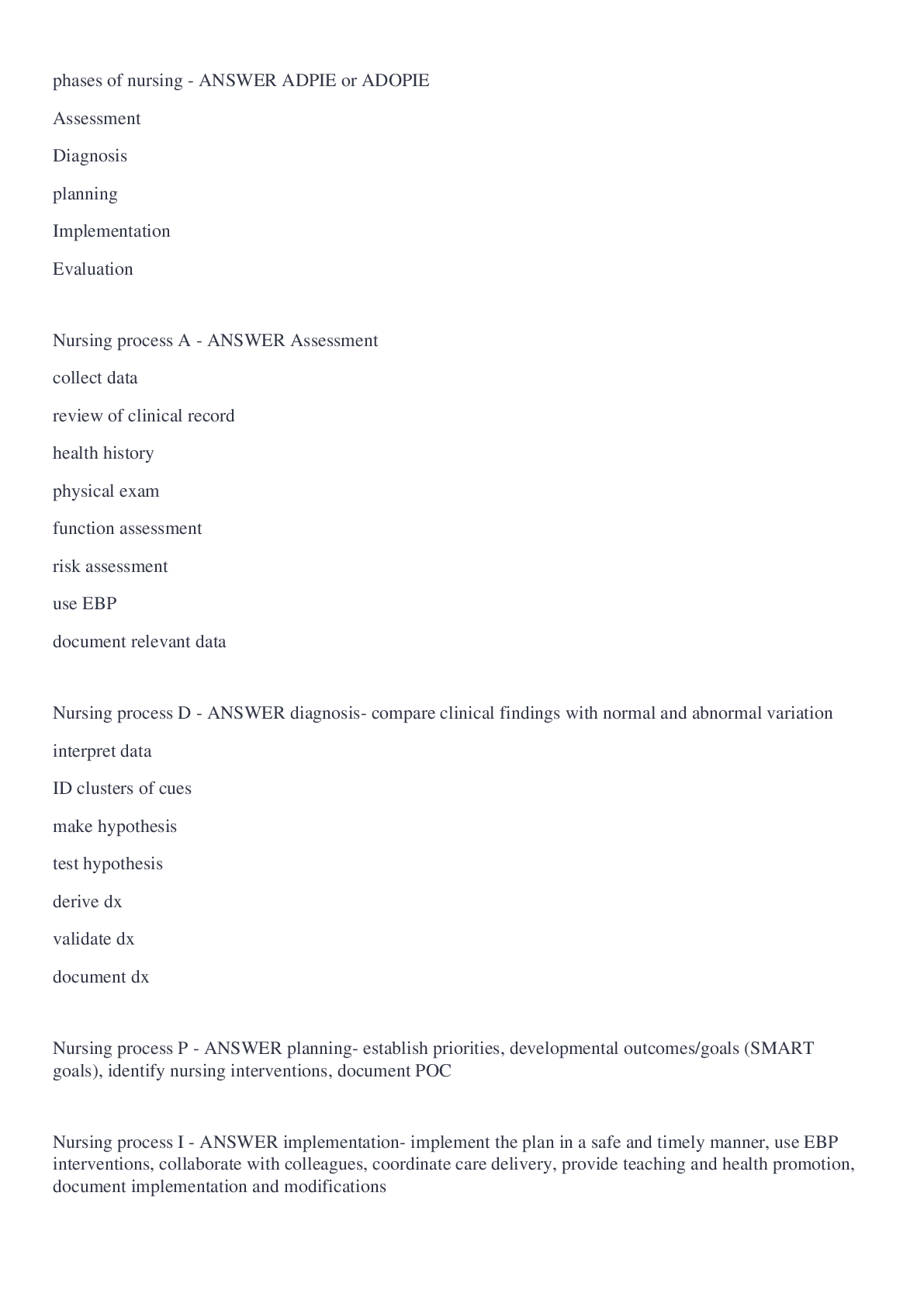
Reviews( 0 )
Document information
Connected school, study & course
About the document
Uploaded On
Jul 29, 2022
Number of pages
16
Written in
Additional information
This document has been written for:
Uploaded
Jul 29, 2022
Downloads
0
Views
44

